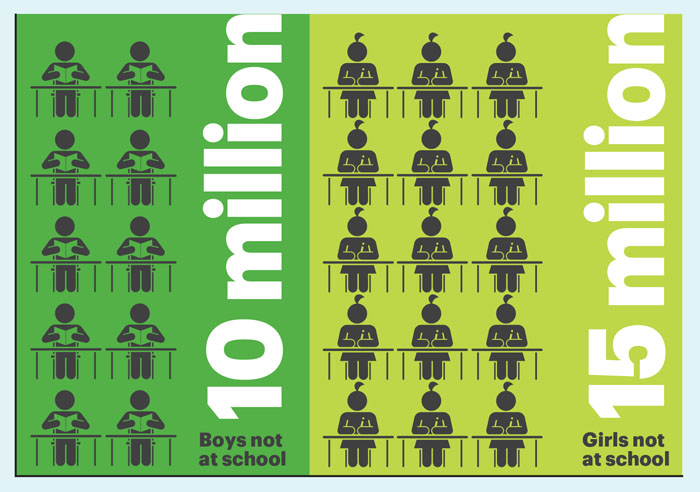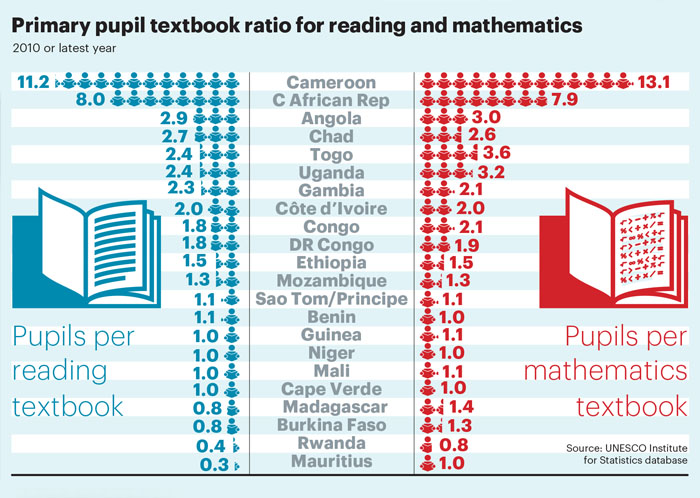Quick wins
Reading difficulties: there are 758 million illiterate adults in the world, according to Unesco figures for June 2016. Of these, 479 million (63%) are women. More than one half of the global illiterate population (51%) lives in South Asia.
Fourfold rise in US college cost: tuition fees in US colleges have increased by 400% over the three decades since the early 1980s, according to the Wall Street Journal. This far outpaces increases in the costs of other goods and services over the same period. However, this rapid rate of growth recently slowed.
Class size at big school: the average class size at lower secondary level across OECD countries is 23. However, there are significant variations. Average class size can reach up to 32 in Japan and Korea and be as low as 19 in Estonia, Luxembourg, Iceland and Slovenia.
Girls left out of class

Girls are more likely to remain uneducated than boys, according to Unesco’s Institute for Statistics. Around 15 million girls of primary school age will not get the chance to learn to read or write in primary school, compared with 10 million boys. More than half of these uneducated girls live in sub-Saharan Africa.
Poverty creates an additional barrier, Unesco says. In the poorest regions of northern Africa and western Asia, only 85 girls for every 100 boys of lower secondary school age are in school. For older children, only 77 of the poorest girls are in school.
Education spending

Countries around the world spend an average of 4.77% of gross domestic production on primary education, according to World Bank figures. Spending is highest in Latin America and Caribbean at 5.70%, followed by east Asia and Pacific at 4.87%.
In Europe and Central Asia, spending on primary education averages 4.83%, while in the Middle East and north Africa it is 4.75%. It is lowest in sub-Saharan Africa (4.63%) and south Asia (3.81%). The World Bank notes that, while levels of expenditure may be comparable between countries, outcomes can vary widely. Globally, spending has started to pick up after a dip following the financial crash.
Towers of PISA

Singapore has the best education system in the world, according to the OECD’s Programme for International Student Assessment (PISA) study.
This evaluates the quality, equity and efficiency of school systems around the globe. A 2015 test of more than half a million 15-year-olds in 72 countries found that Singapore consistently emerges as the strongest all-round performer in science, reading and maths. Other top countries for education include Japan, Estonia, Finland and Canada.
Text book examples

As many as 13 primary school children are sharing one text book in some of the poorest African countries, Unesco figures reveal.
Text book ratios are highest in Cameroon and the Central African Republic. In Cameroon, for example, 13 children share one maths book, while 11 share one reading book. Mauritius, Rwanda and Burkina Faso have much better primary pupil:textbook ratios.
Is it worth it?

Just over one third of British graduates who left university between 2010 and 2017 do not think it was worth the cost.
YouGov research earlier this year found that 35% of those with a loan disagreed that the “costs of going to university were worth it for the career prospects/
learning I gained”. However, six in 10 (61%) agreed.
YouGov’s polling also identified significant pessimism among graduates about ever becoming free of the burden of student debt during their working lives.
Forty one per cent of students and graduates surveyed anticipated they would never pay it off.
Syrian schools bear brunt of war
More than half of Syria’s education facilities have been damaged by conflict, a World Bank review has found. Of these, 10% have been destroyed completely.
Education outcomes had been improving in the Middle Eastern country, with 93% of children enrolling for primary – the average for the region and higher than average for middle income countries. The country’s gender gap was negligible and student learning outcomes were better than most in the Mena region.
However, education sites became military bases and targets, especially vocational institutes, secondary schools and education offices; primary schools and universities remained largely intact. In Aleppo, 49 facilities were destroyed.
According to World Bank estimates, 57% of education facilities in Syria are still running, although access to electricity, water and sanitation if often limited.



















